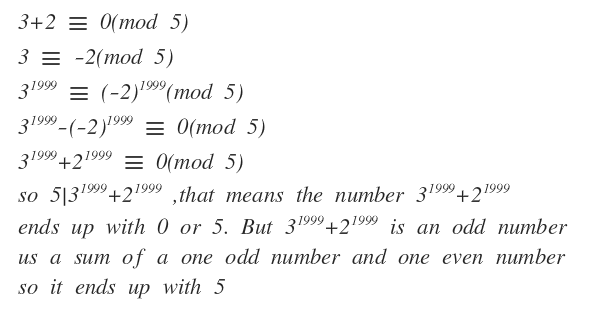Number theory
What is the last digit of 3 1 9 9 9 + 2 1 9 9 9 ?
The answer is 5.
This section requires Javascript.
You are seeing this because something didn't load right. We suggest you, (a) try
refreshing the page, (b) enabling javascript if it is disabled on your browser and,
finally, (c)
loading the
non-javascript version of this page
. We're sorry about the hassle.
3 solutions
Moderator note:
This solution is essentially equivalent to using modulo.
It could be improved by providing explanation for why "we can now assume that the pattern happens every 4th power".
Let us consider 3 1 9 9 9 mod 10 and 2 1 9 9 9 mod 10 separately.
3 1 9 9 9 ≡ 3 1 9 9 9 mod ϕ ( 1 0 ) (mod 10) ≡ 3 1 9 9 9 mod 4 (mod 10) ≡ 3 3 (mod 10) ≡ 7 (mod 10) Since g cd ( 3 , 1 0 ) = 1 , Euler’s theorem applies.
Now consider 2 1 9 9 9 mod 2 and 2 1 9 9 9 mod 5 separately.
2 1 9 9 9 2 1 9 9 9 ⟹ 2 1 9 9 9 ≡ 0 (mod 2) ≡ 2 1 9 9 9 mod ϕ ( 5 ) (mod 5) ≡ 2 1 9 9 9 mod 4 (mod 5) ≡ 2 3 (mod 5) ≡ 3 (mod 5) ≡ 8 (mod 10) Since g cd ( 2 , 5 ) = 1 , Euler’s theorem applies.
Therefore, we have:
3 1 9 9 9 + 2 1 9 9 9 ≡ 7 + 8 (mod 10) ≡ 5 (mod 10)

Easy Solution:
This solution is for a more easier approach other than using modulo.
First, instead of actually solving 3 1 9 9 9 and 2 1 9 9 9 , we can find the last digit of both of these two large numbers by finding a pattern.
First, lets find the last digit when the exponent is 0, then 1, then 2 and so on:
3 0 = 1; 2 0 = 1
3 1 = 3; 2 1 = 2
3 2 = 9; 2 2 = 4
3 3 = 7; 2 3 = 8
3 4 = 1; 2 4 = 6
3 5 = 3; 2 5 = 2
At this point, we could wonder if this reoccurring pattern will happen every 4th power. We can check it by finding out the next time the last digit will be equivalent to the first number.
5 + 4 = 9
3 9 = 3; 2 9 = 2
Now, we can assume that the pattern happens every 4th power. Utilizing the pattern, the problem would be solve very easily.
3 1 9 9 9 = 3 × 3 2 ; 2 1 9 9 9 = 2 × 2 2
3 1 9 9 9 = 7 ; 2 1 9 9 9 = 8
7 + 8 = 15; last digit = 5